Designing Little Ponds Without Spillways
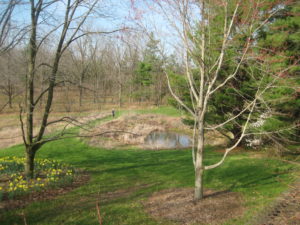
Some small ponds, retained by berms and with very small watersheds, can be designed to work adequately without a separate spillway. But the excess runoff from extreme rainfall still needs to go somewhere without causing an erosion problem. Therefore, without a spillway, the little dam or berm that retains the pond also becomes the overflow. So the top of this berm needs to be dead level to spread the overflow out thinly all across it. And the downhill side of this berm needs to be well vegetated, preferably with grasses. Our example today is one I built about 40 years ago.
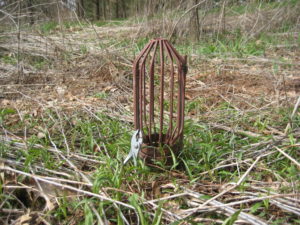
The inlet of the 4 inch trickle tube, with muskrat-proof grate, and a pair of pliers for scale.
Barbara is standing on the top of the grassy berm. This pond has overflowed its berm twice without problems. In both cases, the maximum depth of overflow was 2-5 inches due to irregularities in the berm top. These lasted about an hour and caused no damage.
Reasons for the brief and thin overflow include that the watershed is only about an acre, is well vegetated, and not really steep – all of which slows incoming overland flow. The little pond also has a trickle tube with its inlet about two feet below the top of the berm.
The tube runs down through the berm and exits below. Over the course of a day or two the tube can lower the pond to its inlet level, which creates storage for the next storm. It also keeps the upper soils of the berm from getting saturated and becoming weak and erodible.
All of the above combine so that only occasionally the berm actually overflows – without causing damage; so a separate spillway hasn’t been necessary.
This pond was designed and built specifically for our little frog species: the chorus frog, the cricket frog, two species of tree frog, and the spring peeper, plus the American toad. All breed there in most years except perhaps the spring peeper. We are near the western edge of its range and its call is high-pitched beyond my failing hearing range, so I may have missed it amongst the springtime din of the other species.
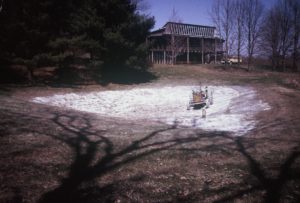
This pond basin caters to the small species by being built above the local shallow water table so that it normally holds water in spring and early summer, but dries up mid to late summer or autumn. This allows these species to complete their life cycle and move into the surrounding watershed. But the big frogs – the bullfrog and green frog, who eat the little frog species – have big chunky tadpoles, which need a second spring of pond water to survive, so they are excluded from successfully breeding and thriving here.
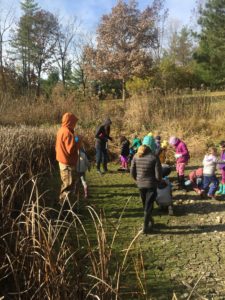
The Prairie Green schoolchildren in the dry pond basin looking for little frogs. The dry “grass” on the left is burreed, a wetland native.
This pond captures rain runoff from its one-acre watershed, which includes our house roof, so there is always a bit of runoff, even from little rains. While building the pond, I also lightly coated the dirt with bentonite clay powder and packed it in with my tractor tires to slow the leakage rate.
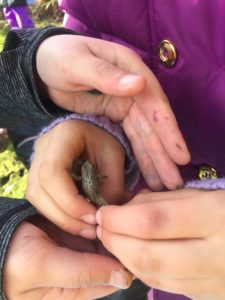
A small captive.
The side slopes were planted to natives and the floor has gradually accumulated a layer of washed-in dirt and organics. In late autumn, this layer dries out and some of the little frogs move back in to hibernate for winter.
So if you are thinking about building a frog pond somewhere on your property, remember that one located on the higher ground will have a smaller watershed and less water available from ordinary rains, but will also have less water to cope with during big storm events and may not need a spillway.


